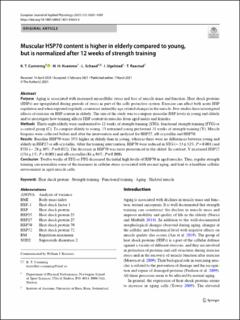| dc.contributor.author | Cumming, Kristoffer Toldnes | |
| dc.contributor.author | Kvamme, Nils Helge | |
| dc.contributor.author | Schaad, Laura | |
| dc.contributor.author | Ugelstad, Ingrid | |
| dc.contributor.author | Raastad, Truls | |
| dc.date.accessioned | 2021-09-22T15:30:10Z | |
| dc.date.available | 2021-09-22T15:30:10Z | |
| dc.date.created | 2021-06-17T13:02:45Z | |
| dc.date.issued | 2021 | |
| dc.identifier.citation | European Journal of Applied Physiology. 2021, 121(6), 1689-1699. | en_US |
| dc.identifier.issn | 1439-6319 | |
| dc.identifier.uri | https://hdl.handle.net/11250/2780431 | |
| dc.description | This article is licensed under a Creative Commons Attribution 4.0 International License, which permits use, sharing, adaptation, distribution and reproduction in any medium or format, as long as you give appropriate credit to the original author(s) and the source, provide a link to the Creative Commons licence, and indicate if changes were made. The images or other third party material in this article are included in the article’s Creative Commons licence, unless indicated otherwise in a credit line to the material. If material is not included in the article’s Creative Commons licence and your intended use is not permitted by statutory regulation or exceeds the permitted use, you will need to obtain permission directly from the copyright holder. | en_US |
| dc.description.abstract | Purpose: Aging is associated with increased myocellular stress and loss of muscle mass and function. Heat shock proteins (HSPs) are upregulated during periods of stress as part of the cells protective system. Exercise can affect both acute HSP regulation and when repeated regularly counteract unhealthy age-related changes in the muscle. Few studies have investigated effects of exercise on HSP content in elderly. The aim of the study was to compare muscular HSP levels in young and elderly and to investigate how training affects HSP content in muscles from aged males and females.
Methods: Thirty-eight elderly were randomized to 12 weeks of strength training (STG), functional strength training (FTG) or a control group (C). To compare elderly to young, 13 untrained young performed 11 weeks of strength training (Y). Muscle biopsies were collected before and after the intervention and analyzed for HSP27, αB-crystallin and HSP70.
Results: Baseline HSP70 were 35% higher in elderly than in young, whereas there were no differences between young and elderly in HSP27 or αB-crystallin. After the training intervention, HSP70 were reduced in STG (− 33 ± 32%; P = 0.001) and FTG (− 28 ± 30%; P = 0.012). The decrease in HSP70 was more pronounced in the oldest. In contrast, Y increased HSP27 (134 ± 1%; P < 0.001) and αB-crystallin (84 ± 94%; P = 0.008).
Conclusion: Twelve weeks of STG or FTG decreased the initial high levels of HSP70 in aged muscles. Thus, regular strength training can normalize some of the increases in cellular stress associated with normal aging, and lead to a healthier cellular environment in aged muscle cells. | en_US |
| dc.language.iso | eng | en_US |
| dc.subject | aging | en_US |
| dc.subject | functional training | en_US |
| dc.subject | heat shock protein | en_US |
| dc.subject | skeletal muscle | en_US |
| dc.subject | strength training | en_US |
| dc.title | Muscular HSP70 content is higher in elderly compared to young, but is normalized after 12 weeks of strength training | en_US |
| dc.type | Peer reviewed | en_US |
| dc.type | Journal article | en_US |
| dc.description.version | publishedVersion | en_US |
| dc.rights.holder | © The Author(s) 2021 | en_US |
| dc.source.pagenumber | 1689-1699 | en_US |
| dc.source.volume | 121 | en_US |
| dc.source.journal | European Journal of Applied Physiology | en_US |
| dc.source.issue | 6 | en_US |
| dc.identifier.doi | 10.1007/s00421-021-04633-4 | |
| dc.identifier.cristin | 1916410 | |
| dc.description.localcode | Institutt for fysisk prestasjonsevne / Department of Physical Performance | en_US |
| cristin.ispublished | true | |
| cristin.fulltext | original | |
| cristin.qualitycode | 1 | |
